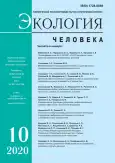Цель исследования - выявление особенностей распределения уровня постоянного потенциала (УПП) у пациентов с вибрационной болезнью (ВБ) в сочетании с метаболическими нарушениями. Методы. Обследуемые распределены на группы: I (n = 94) - с ВБ, II (n = 42) - с ВБ, отягощенной метаболическим синдромом (МС), III (n = 31) - с ВБ, отягощенной сахарным диабетом 2 типа (СД2), IV (n = 14) - с СД2, V (n = 50) - группа сравнения. Применены методы статистического анализа с определением W-критерия Шапиро - Уилка, U-критерия Манна - Уитни, дискриминантный анализ. Результаты. В I-IV группах доля лиц с измененной нейроэнергетической активностью выше, чем в группе сравнения (р = 0,001; 0,003; 0,01; 0,009 соответственно). В I группе УПП преобладал в центральном, во II - в левом центральном, правом височном, в III - в левом центральном, центральном, в IV - в правом лобном, центральных, левом теменном отведениях при сопоставлении с V группой при р < 0,01. У пациентов II-IV групп диагностировано снижение УПП в передних отделах коры (лобных, височных: 16,6 (15-18) мВ, 14,7 (12-17) мВ, 17,6 (16-20) мВ соответственно), его увеличение в задних (центральных, теменных: 20,4 (16-25) мВ, 18,2 (14-20) мВ, 23,3 (17-28) мВ соответственно) при р < 0,01. В результате дискриминантного анализа в I и III группах выявлено два признака: значения показателей УПП в левом височном, правом центральном отведениях. Выводы. Нарушения нейроэнергообмена у пациентов с ВБ в сочетании с МС и СД2 проявляются увеличением УПП в височно-центральных областях, при СД2 - в лобно-центрально-теменных отделах. У пациентов с ВБ, отягощенной СД2, увеличивается значение УПП в правом центральном и снижается в левом височном отведениях.
 4-9
4-9


 10-16
10-16


 17-22
17-22


 23-30
23-30


 31-37
31-37


 38-44
38-44


 45-54
45-54


 55-64
55-64








